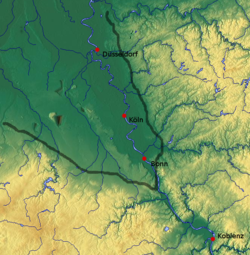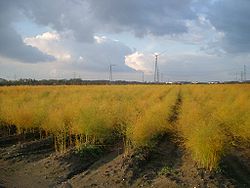- Cologne Lowland
-
The Cologne Lowland[1][2] (also Cologne Bight or Cologne Bay[1]) (German: Kölner Bucht) is a densely populated area of Germany lying between the cities of Bonn, Aachen, and Düsseldorf/Neuss. It is situated in the southwest of the state of North Rhine-Westphalia and forms the natural southern conclusion of the Lower Rhenish lowlands and the transition to the Rhenish Massif (Rheinische Schiefergebirge or "Rhenish Slate Mountains"). The Cologne Bight is surrounded on the left bank of the Rhine by the High Fens and the Eifel, as well as by the Bergisches Land on the Rhine’s right bank. In the south and southeast the rising Rhine Massif, visible from far off by the silhouette of the Siebengebirge, form the conclusion of the bight at Königswinter. To the northwest the Cologne Bight opens out into the valleys of the Rhine and the Meuse, in the northeast it is bounded by the Münsterländer Kreidebecken (Münster Chalk Basin) of the Westphalian Bight.
Contents
Climate and geology
The Cologne Lowland is among the warmest regions in Germany. While the summers on the upper Rhine are somewhat warmer, winters in the area are so mild that snow remaining on the ground for as much as several days would have been considered rather exceptional in the decades before the onset of the current climatic change. Due to the orographic rainfall on the surrounding mountain ranges the climate is relatively damp as well. In combination with the valuable loess soil, these factors make the Cologne Bight one of the most fertile regions of Germany.
About 30 million years ago, parts of the Rhine Massif sank and formed a lowland region. Due to the subtropical climate at that time, there was a luxuriant plant growth of abundant varieties. About 15 million years ago, these plants died out and formed a peat layer up to 270 meters thick. From the pressure of earth layers lying over it, the peat was compressed into lignite (brown coal).
The predecessors of today's Rhine dug a broad river bed through the rock. These Rhine forerunners brought debris from the Alps, the Eifel, the Hunsrück, and the Westerwald. Where the water flowed slowly (in the shallow water zones), clay was left behind; where it flowed fast, sand and gravel settled. The shores of the North Sea in those days occasionally reached up to where the cities of Aachen, Erkelenz, and Mönchengladbach are today.
The Cologne Lowland is also seismically active today.
The region is characterized by its agriculture (with orchards and truck farms), by open-pit lignite mining, by the landscapes of the Voreifel and the Bergisches Land as well as by 325 fortresses and castles, which were usually built as water castles.
Translated from the German Wikipedia
See also
List of places in North Rhine-Westphalia
References
Bibliography
- Brune, Bert, and Hans Bender. 1990. Kölner Bucht: Natur und Unnatur—ein Lesebuch, edited by Bert Brune and Frieder Döring, with drawings by Karl Peters. Cologne: Wolkenstein-Verlag. ISBN 3927861081
- Dickinson, Robert Eric. 1953. Germany: A General and Regional Geography. Methuen's Advanced Geographies; Dutton Advanced Geographies. London: Methuen; New York: Dutton. (Second edition, London: Methuen; New York: Dutton, 1961)
- Elkins, T. H. 1968. Germany: An Introductory Geography, revised edition. Praeger Introductory Geographies. London: Chatto & Windus; New York: Praeger. ISBN 0701000872 (Third edition, London: Chatto & Windus, 1972. ISBN 0701106514)
- Friedrich, Reinhard and Bernd Päffgen. 2007. Mittelalterliche Burganlagen in Kölner Bucht und Nordeifel bis zum Ende des 13. Jahrhunderts. Publikationen der Gesellschaft für Rheinische Geschichtskunde, neue Folge 12, Abt. 1b. Bonn: Habelt-Verlag. ISBN 3774934347
- Krämer, Karl Emerich and Eva Umscheid. 1988. Von Burg zu Burg zwischen Köln und Aachen, 2nd expanded edition. Duisburg: Mercator-Verlag. ISBN 3874631176
- Schamp, Elke W. (ed.). 1972. Kölner Bucht und angrenzende Gebiete, edited and collected by members of the Geographical and of the Business and Social-geographical Institutes of the University of Cologne. Sammlung geographischer Führer 6. Berlin and Stuttgart: Borntraeger.
Further reading
- Pastor, Johannes. 2007. "Environmental Aspects of Mine Closures and Abandoned Mine Site Rehabilitation in Germany". Paper presented at the 28. Convención Minera - 28th Mining Convention and Conference, September 11, 2007, Arequipa, Peru.
External links
- Koelnerbucht.de Online magazine for the cities and regions of the Cologne Bight (German)
Categories:- Geography of North Rhine-Westphalia
- Geography of Cologne
- Natural regions of Germany
- Rhineland
Wikimedia Foundation. 2010.



